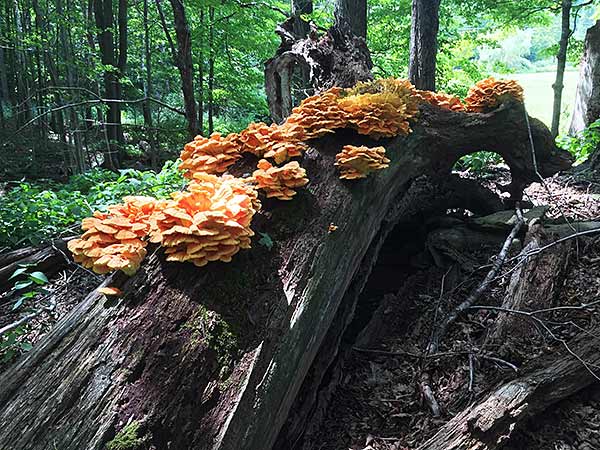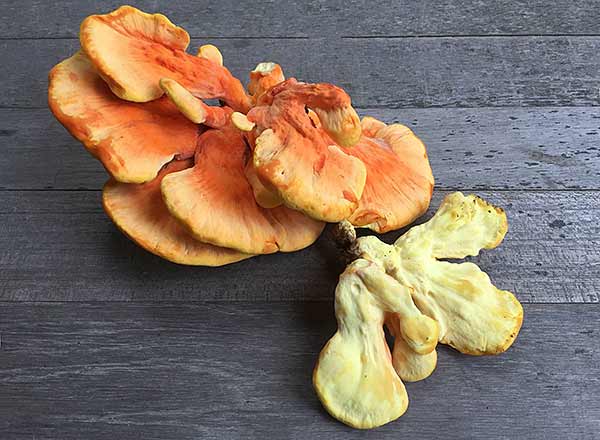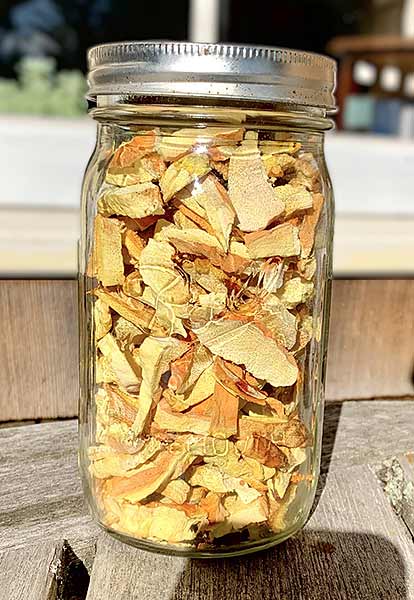Dehydrated Foods
Cooking, Preparing and Drying Chicken of the Woods Mushrooms
(by J. Craig Robertson)
Among the most versatile types of edible fungus, Chicken of the Woods mushrooms are a delicious treat that can be found all summer long, usually after a rainy spell. Most often they will be found on fallen logs in various stages of decomposition. They also grow from the trunks of living trees and sometimes appear on the ground sprouting up from the roots of living or dying trees. In New England, where I do all of my foraging, they are most often found on oaks or other hardwoods.
Searching for them is a pleasure. Simply hike through a favorite forest or along a new trail that goes through a wooded area and let your gaze wander through the trees on either side of your path as you walk. In the cool forest light the vivid orange bracts show up from a surprising distance away and often seem to simply reach out and grab your attention. One minute you are wandering through deep green woods and the next you have stumbled across a very fine addition to dinner.

Early this summer I encountered this immense ash log with at least 20 or 25 kg of “chickens” growing from it.
Equipment: Brød & Taylor Sahara Folding Dehydrator
Time & Temperature: 43 C for 10 hours and then, reduce the heat to 37 C for about 3 more hours.

Now that you have some in hand, look them over and determine what kind of condition they are in. Young and tender specimens will be soft to the touch and flexible. They will be a brilliant and varied orange on top and a very bright sulphur yellow underneath.
Older specimens will have a faded look, might be mushy feeling, and could contain an impressive amount and variety of insect life. Harvest them by pulling or cutting them off at the base where they are attached to the log or tree. Handle them carefully to keep them from bruising, particularly along the very tender outer edges of the bracts.

Back in the kitchen you can pull apart and separate the layered fruiting body into individual fronds. Shake or brush off any insects or debris. After that I like to start from the narrow or stalk end of the frond and make slices across the base. As you slice you should be able to feel how woody or sinewy that part of the fungus is. Discard the coarse and tough parts and once you start cutting into something that you can imagine cooking and eating set that frond aside and trim the next. When all of the fronds are prepped they are ready for slicing or cooking.
The portion that you plan to eat can, in theory, be prepared using any recipe for a chicken dish that you like. My experience is that cooking them in a skillet on medium heat for a longer time and finishing them by cooking them covered for a few minutes yields a tender and flavorful dish.

The finished product.
One of my favorite attributes of this particular member of the fungi kingdom is that it is often found in large fruitings. It is not unusual to come across 2 or 3 or even 5 kg on a single tree. Drying what you are not going to eat fresh is easy, and will preserve your find until you are ready to enjoy them later. Simply keep slicing the cleaned fronds from the stem end into narrow strips about 0,5 cm thick. Cutting across the “grain” of the frond will make the pieces more tender. The thin margin of the frond can be left intact or cut into any preferred size. Then lay them out on the dehydrator shelves and load them in.
Moisture content and drying time will vary from mushroom to mushroom so I dried them at 43 C for 10 hours and then, after checking, reduced the heat to 37 C for about 3 more hours. This left them just a bit leathery and but easy to snap. After that they can be put in a glass jar or a plastic bag and stored until you are ready to use them.
Dried Chicken of the Woods work well in a soup, stew or any dish with a long cooking time. You can re-hydrate by soaking in water for 15-30 minutes and then sautee and spice them before adding them to what’s on the stove or simply put them in dry and let them absorb moisture from the dish.




 Select Country
Select Country











